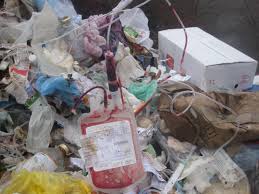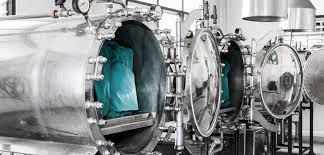Waste (also known as rubbish, trash, refuse, garbage, junk, litter) is unwanted or useless materials. In biology, waste is any of the many unwanted substances or toxins that are expelled from living organisms; such as urea, sweat or faces. Litter is waste which has been disposed of improperly.
Waste is directly linked to human development, both technologically and socially. The compositions of different wastes have varied over time and location, with industrial development and innovation being directly linked to waste materials.
An Example of this include plastics and nuclear technology. Some components of waste have economic value and can be recycled once correctly recovered.
There are many waste types defined by modern systems of waste management, notably including:
– Municipal Waste includes household waste, commercial waste, and demolition waste
– Hazardous Waste includes Industrial waste
– Bio-medical Waste includes clinical waste
– Special Hazardous waste includes radioactive waste, Explosives waste, E-waste
Read Also: Different Types of Hospital Wastes
Waste is sometimes a subjective concept, because items that some people discard may have value to others. It is widely recognised that waste materials are a valuable resource, whilst there is debate as to how this value is best realised. Such concepts are colloquially expressed in western culture by such idioms as “One man’s trash is another man’s treasure.”
Sources of Waste
Everything on the planet earth, living or non-living has its source, waste is not an exception. On volumes or mass.
- Domestic
- Industrial
- Commercial
- Agricultural
- Construction
- Mining
Taxonomically, waste can be categorized in terms of state of matter i.e: solid, liquid and gaseous.
Also, it can be toxic, hazardous or volatile. A typical solid domestic waste will consist of paper, glass, plastic, metals, textiles, woods, vegetables etc. liquid waste include gey water, kitchen sludges, oils, grease while gaseous include CH4, CO2, CO, aerosols.
Identification of waste source helps in giving proper nomenclature to waste. It also helps in identification of the required collection, storage, transportation and disposal. Similarly, analysis of waste involves quantification in volumes or mass.
Waste Management Process
Waste management is the collection, transport, processing, recycling or disposal, managing and monitoring of waste materials. The term usually relates to materials produced by human activity, and is generally undertaken to reduce their effect on health, the environment or aesthetics.
Waste management is also carried out to recover resources from it. Waste management can involve solid, liquid, gaseous or radioactive substances, with different methods and fields of expertise for each.
Waste management practices differ for developed and developing nations, for urban and rural areas, and for residential and industrial producers. Management for non-hazardous waste residential and institutional waste in metropolitan areas is usually the responsibility of local government authorities, while management for non-hazardous commercial and industrial waste is usually the responsibility of the generator.
1. Integrated waste management
Integrated waste management using LCA (life cycle analysis) attempts to offer the most benign options for waste management. For mixed MSW (Municipal Solid Waste) a number of broad studies have indicated that waste administration, then source separation and collection followed by reuse and recycling of the non-organic fraction and energy and compost/fertilizer production of the organic waste fraction via anaerobic digestion to be the favored path.
2. Waste Storage
Storage of waste takes place at the spot where the waste is generated. Domestic refuse is normally stored continually in a container or sack until collected. The daily production is usually stored inside until it is carried outside for collection. There can be 1 unit/household or per several households, or local communal collection points where garbage is emptied in a bin or container.

Read Also: Recommended Methods of Waste Disposal
In some developing countries, old oil barrels, concrete tubes and other improvised enclosures may be used for storage often without any systematized garbage collection taken place. Industry and business often have their own systems with relatively large storage units.
Some factories run large refuse heaps on the factory‘s premises without any form of regular collection. Containers used as storage units are common for a great many industries and outside large market places.
3. Waste Collection
Collection of waste generally take place by loading from the storage containers unto a vehicle e.g. hand-cart (simple), donkey-cart (complex), tractor with trailer (sophisticated), special garbage truck.
The garbage is usually collected and emptied by the crew of the vehicle (garbage collectors) but in some cases, collectors make a sound signal in which members come and empty their garbage into the vehicle.
Collection requires passable routes and the choice of technology must be adapted to the existing quality of roads, streets and settlement.
A simple cart can often be more useful than a modern garbage truck and labor intensive method, more efficient than modern mechanized ones. The choice of technology should also be considered on the basis of available facilities for maintenance. In some places, tractors ordinarily used for agricultural purposes have proved useful for collection and transportation of waste.
Moreover, in agricultural areas where tractors are sued, there is often a food infrastructure with garages available spare parts. Where there is systematic collection, small scale industries and businesses are usually included.
Major manufacturing industries producing large amount of waste usually run their own system for collection and transport.
Collections of liquid waste (sludge) from waste water treatment plants require separate collection routes.
Also, gaseous wastes are often collected through emission pipes (stacks) to be emitted into the atmosphere.
In summary, Waste management is the collection, transport, processing, recycling or disposal, managing and monitoring of waste materials. The term usually relates to materials produced by human activity, and is generally undertaken to reduce their effect on health, the environment or aesthetics.
Waste management is also carried out to recover resources from it. Waste management can involve solid, liquid, gaseous or radioactive substances, with different methods and fields of expertise for each.
Waste management practices differ for developed and developing nations, for urban and rural areas, and for residential and industrial producers.
Management for non-hazardous waste residential and institutional waste in metropolitan areas is usually the responsibility of local government authorities, while management for non-hazardous commercial and industrial waste is usually the responsibility of the generator.

